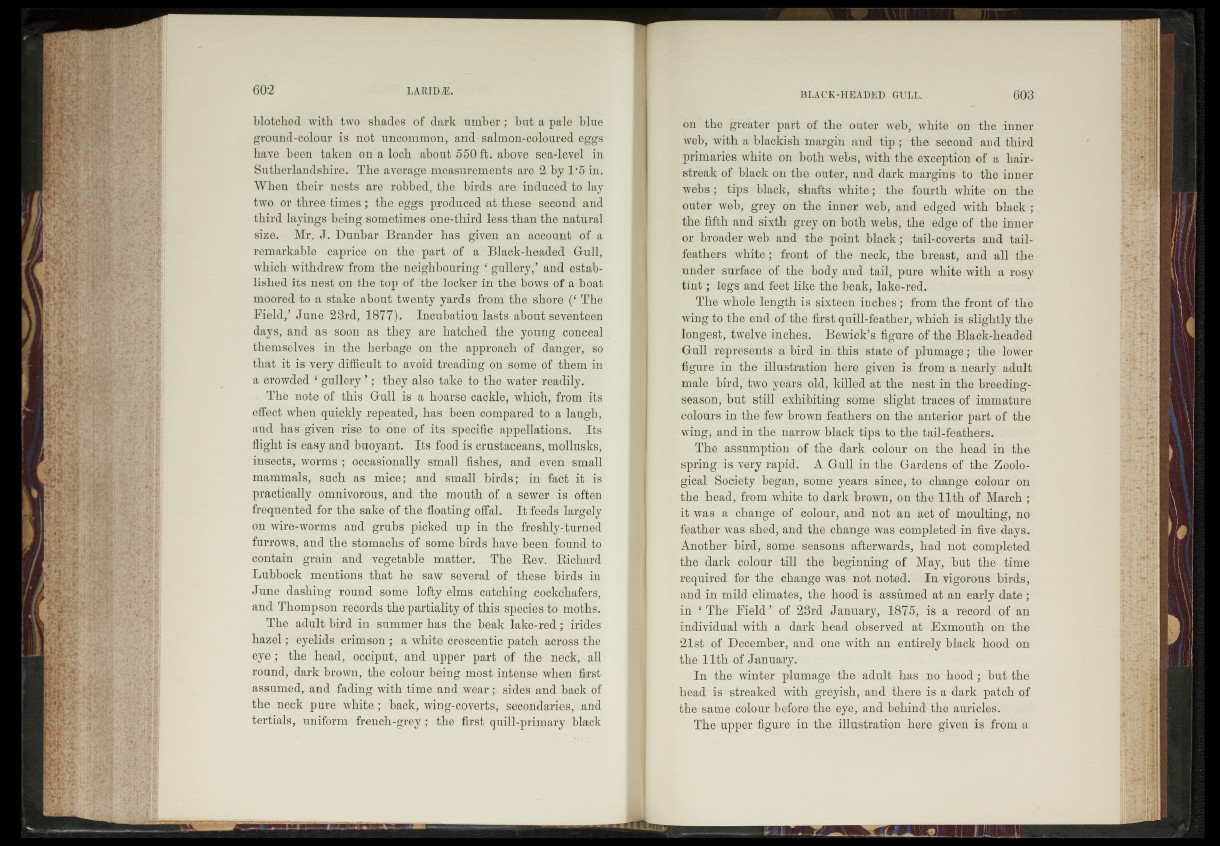
blotched with two shades of dark umber; but a pale blue
ground-colour is hot uncommon,! and salmon-coloured eggs
have been taken on a loch about 550 ft. above sea*level in
Sutherlandshire. The average measurements are 2 by l -5 in.
When their nests are robbed, the birds are induced to lay
two. or three times; the eggs produced at these- second and
third layings being sometimes one-third lessthan the-natural
size. Mr. J. Dunbar Brander has given an account Of-.a
remarkable caprice on. the part of a Black-headed Gull,
which withdrew from the neighbouring ‘ gullery,’ and established
its nest on the top of the locker in the bows of a boat
moored to a stake about twenty yards from the shore (‘ The
Field,’ June 23rd, 18i77;); f Ineubidibp lasts about seventeen
days, and as soon as they are hatched.,;the young feöUóeal
themselvés in the herbage ton.'theapproach of dangery so
that it is very difficult to avoid treading bn some of them in
a crowded I gullery ’ ; they:also take to the water readily,';
; The note of this Gull is a hoarse cackle, which, from its
effect when quickly repeated, has .been compared to-alaughy
and has given rise to one of itsuspecific appellations. Its
flight is easy and buoyant. Itsfood is crustaceans, ïpollusks,
insects, worms* occasionally small, fishes, and even- small
mammals, such as mice; andystnall birds; in faét it; is
practically .omnivorous, and the mouth,of’a sewer£i#-Often
frequented for the sake of the floating offal. It feeds largely
on wire?-worms and. grubs, picked up in the freshly-turned
furrows, and tile-stomachs of ."some birds-have been foundbo
contain grain and vegetable matter, j The;-Rev. Richard
Lubbock mentions that he -saw . several of; these* birds in
June dashing round some lofty ,elms catching^ cockchafers,
and Thompson records the partiality of thiêi sp^ieSïfo^raDths.
The adult bird in summer has the ’beak lake-red ,fï#Me.s
hazel ,i‘‘eyelais"-crimson ; a white sbfeseenfic -patch- across the
eye; the head, ; occiput, and upper part of the jn-ecky-ah
round, dark brown, the colon# bei^most? intense whenj first
assumed, and fading with time and-wear.-;- sideband back.of
the. neck, purè white#.; back, winghcoverts, secondaries,:-,a’nd
tertials, uniform french-grey,f the first quill-primary black
bn the greater part of the outer, web, white on the inner
web, with a blackish margin and tip ; the. second and third
primaries, white. - on both webs, vdM^e ^ c é ip tó r «ff a hair-
streak of. black on the outer, and dark margins to the inner;
webs ; tips black, shafts white*; the fourth white- on* the
outer web,- greyton -the inner web, and edged-with black;
the fifth and sixth" grey on-both webs,,the -êdge-of the inner
or broader web and the 'point black ; tail-coverts and tail-
feathers white; front of the neck, the'breast, and all the
under surface of" the. body and tail; pure white with- a rosy
tint ; 41'Ogsc andfeet like thé beak, lake-red.
The whole length is sixteen;inches;' from the front of thè,
W-ihg to-the end of the first quill-feather j which is; slightly the
ffengest, twelve inches. Bewick’s figure of the .Black-headed
Gull,represents a bird in this- state of plumage; the'lower
figure; in. the illustration Here give® is. from-a nearly,-adult
male bird, two-years old; killed at the neat-in the breeding-
season;- biït^stîli exhibiting some slight traces of immature,
èölours iç thérdtw brown feathers'on the anterior part-of the
wing, and in the narrow black tips to the taikfeathers. É
The assumption of the dark Colour on the; head in the
spring is-very rapid. A *Galh^the’ Gardens of the Zoological'Society
began, some years since,-; to-change colour ;on
thè! headÿ from whitofato dark brown, orrtfafe^llth of March ;
it was a~ change of-Colour^ and not" an ant of moulting, .no
feather, was shed, and the changes-was completed in five" days..
Another bird, some-:seasons afterwards, had not completed,
the dark- éolót®' till the*,beginningIof May, but the time-
required for' thé changé was iiofmoted. In vigorous birds,
and iilïmild climates, thO-hood-'is assumed at an early date ;
in ‘ The Field ’ ‘-<M 23rd' January,-: 1875Y is a record, of an
individual with a dark head observed at ttFiÊmiùth onOthe*
-2dbs.t of December, and one with an entirely black hood -on
f he-Tlth- of January. .
In thei#feter plumage the todul-t has rnowkbod yjbut fee'
head dsi streaked withagreyish, arid there is a dark patch of
the same-colour; before,the,eye; and behind the auricles.
The upper figure in the illustration here given is from a